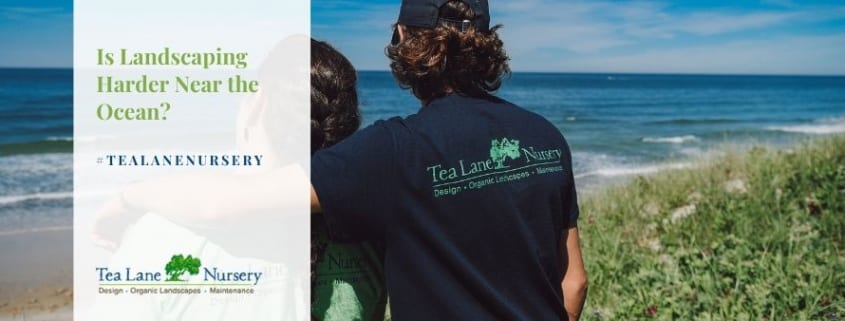Is Landscaping Harder Near the Ocean?
Landscaping near the ocean is a bit more challenging than typical land cultivation. Gusty winds, higher humidity, and salt concentrations are some of the coastal climates that trouble seashore cultivators.
Early Tips for Landscaping Near the Ocean
When these factors combine, they will destroy leaves and prevent plants from growing. But is it that difficult to give your seaside property a beautiful garden? No, it is not. Know about the effective solutions to overcome those challenges for attractive landscaping!
Choose sturdy and salt-resistant plants
To increase the oxidation, plants consume water from the ground through osmosis, a mechanism in which water travels from a position with low solute concentrations to one with high amounts. If the groundwater is very salty, it will draw water from the plants, causing them to suffer from water deficit.
Most common plants are susceptible to salt, which can hinder their development or even trigger them to droop and die if they are close to the seaside. It is better to indulge in salt-resistant plants while thinking of landscaping in your seashore property. These salt impenetrable plants not only can withstand salt, but they will also need less grooming and are drought tolerant. This makes it ideal if your home isn’t used (or maintained) all year.
Do proper planning for sunny and stormy weather
Storms and sunny weather are prevalent and known to all coastal residents. Oceanfront residences are built to withstand the necessary conditions since they are prone to more heat and storms than residences in farther offshore sites.
Be sure to choose plants that will not only thrive in the sun (or dappled shade if they’re close to your house or cottages) but will also withstand solid gusty winds and excessive rains. This point is crucial to note down while going for landscaping. To protect the plants, go for better protection of the roots, give proper coverage, wrap-up plants in a reliable fabric, or use frost blankets.
Plump for Gravel for excellent groundcovers
For oceanside landscapes, a mixture of gravel, broken rock, and sand works well as a groundcover. It can support drainage and can withstand the winds and other conditions without being damaged.
Use eco-friendly products and chemicals
Usage of eco-friendly products and chemicals is the next step to organic landscaping. An organic approach maintains a cleaner and more productive soil, with well-balanced carbon and nitrogen cycles. The normal nitrogen fixation in the soil also enhances due to the massive preservation of healthy microbes. Moreover, organic plantation aids in pollution control.
Since you live near the sea and experience higher rainfall, it’s important to prepare ahead to prevent your home’s drainage from polluting the ocean and other habitats such as local wetlands. To help prevent disrupting the natural environment, environmentally friendly products are a must during landscaping. Consider building wetlands or other drainage conservation areas for better results.
Early preparation for preventing soil erosion
Soil erosion is one of the scariest things during cultivation. It leads to degradation in soil quality and increases in soil acidity levels. Further, it affects the drainage, future plant growth, eventually polluting the water. For oceanfront lands, soil erosion is one of the major issues.
Dwellings constructed near the ocean are especially susceptible to this condition. A mixture of native plants, concrete blocks, terraces, and other landscaping elements can help regulate the home’s drainage and soil erosion.
Come up with alternatives for bright lighting
At times there is not enough sunlight for plants due to bad weather conditions near the ocean. It leads to a halt in the plant’s growth. Therefore, setting up artificial lighting beforehand is a must. And it is obvious to install proper lighting fixtures for bright lighting and better landscaping.
For coastal regions, lighting fixtures that do not rust or deform when subjected to elevated moisture and alkalinity are needed. A typical metal pole encased in concrete can rot quickly, basically as soon as humidity penetrates the concrete strength and enters the metallic base. Before buying lighting fixtures, ensure that they are non-porous and non-hygroscopic.
Always go for low-lying leaves
Low-lying plants offer you a great display of the sea view without causing problems. Simultaneously, it also preserves your gardening foliages while being neat and tidy. Vines, large-leaved plants, and soft flowers are all excellent choices for creating an environment that complements the natural beauty of living on the coast.
Moreover, these plants can be easily handled, saving time and effort. Individuals who dream of beautiful and easy landscaping can make its best use.
Stick to native plants
Rather than building a yard and a flowering plant greenhouse, choose native plants for marine landscapes. Native plants can quickly adapt to the local environmental conditions and offer food and shelter for local birds and animals. Furthermore, these plants are drought-tolerant and need less water.
Build windbreaks
When it comes to winds, you should minimize their impact on your plants’ production. The right approach to do this is to strategically place shrubs and trees to build windbreaks in the landscape. You can mix trees and shrubs with a variety of things you have on your land to create windbreaks. You can also use walls and displays for the same. However, make sure there is enough space between them to avoid turbulence.
Improve soil quality
Soil fertility is among the first issues you must tackle. If you live in coastal areas, the soil of your premises is certainly more alkaline. This necessitates the inclusion of organic matter as well as wetting agents to improve soil consistency. It will further increase the soil’s composition as well as its water-holding capability.
Be sure to dig organic material into the ground rather than just spreading it on the surface of the soil when applying it. As a result, there would be stunted growth of weeds.
Takeaway
A residence by the shore can be a beautiful thing to have, whether you live there full-time or only visit during the holidays. Instead of embracing your destiny as a coastline property owner and being accustomed to it, you should take these few steps to fulfill your dream of creating a stunning seashore landscape.
Coastal Landscaping is not that difficult. However, it requires greater attention than regular plantations. If you do not follow proper plantation habits, you may not have the best landscaping experience. Explore more landscaping ideas from Tea Lane Nursery. The teams are landscaping experts who can offer the best designing experiences.







